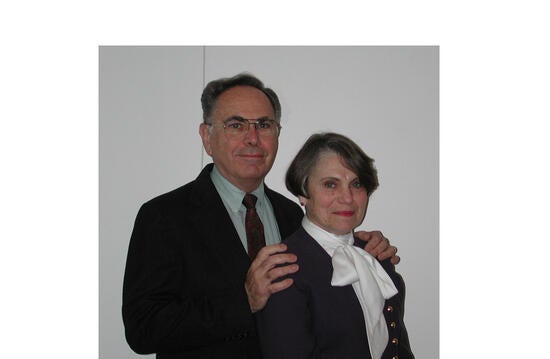
Jane and Jerome Schultz

Jane Schultz
Jane Schultz (1932-2017) earned her B.S. in chemistry from Hunter College in New York City, and was the first woman to earn a master’s degree in chemical engineering at Columbia University. Jane and Jerry met at Columbia in 1953 and married in 1955. While Jerry completed his Ph.D. at Wisconsin, Jane worked as a chemist at the Forest Products Laboratory in Madison.
After returning to New York, Jane taught science at Pearl River High School where one of her students won the state science award. The couple’s three children (Daniel, Judith, and Kathryn), were born during this period. When the family moved to Ann Arbor, Jane pursued her love of biology by obtaining a Ph.D. in human genetics at the University of Michigan's School of Medicine. She was appointed assistant professor of human genetics at UM and established a research program at the Veterans Administration (VA) hospital.
After a few years of research in transplantation and autoimmune diseases, Jane was recruited to Washington, DC to head the grants program of the VA national research service. On returning to the University of Michigan, she was appointed assistant dean of the medical school. After a few years in this position, she was recruited back to Washington by Anthony Fauci as chief of the genetics and transplantation branch of the National Institutes of Health (NIH). After five years at NIH, Jane joined the University of Pittsburgh as director of research administration in the medical school and associate professor of pathology. Later she headed a program to provide human tissues for research with a non-profit company in Philadelphia.
Jane joined the University of California, Riverside when Jerry became the founding chair of the department of bioengineering. As director of research development in the office of research, she created a comprehensive directory of faculty research programs and facilitated their applications for new federal and foundation grants. She also supported faculty advancement by assisting in faculty nominations for national awards.
Jerry Schultz
Jerome (Jerry) Schultz obtained a B.S. and M.S. in chemical engineering from Columbia University and his doctorate in biochemistry from the University of Wisconsin. After a stint in the research division of Lederle Laboratories where he piloted the development of new antibiotics, enzymes, and steroids, he joined department of chemical engineering at the University of Michigan. His research focused on applied microbiology, biomaterials, and carrier-mediated membrane separation. Later he studied diffusion through nanoporous membranes, the development of the first optical biosensor for glucose, and the evaluation of biomaterials for NIH’s artificial heart program. Between 1977 and 1985 he served as chair of the department.
Jerry joined the University of Pittsburgh in 1987 as director of the interdisciplinary center for bioengineering and biotechnology. He also founded a new department of bioengineering and served as its chair. In 1988 he became editor-in-chief of the Journal Biotechnology Progress, which he served on for several decades. He was also a founding fellow and past president of the American Institute of Medical and Biological Engineering. Jerry continued his work on biosensors to develop a concept for the first implantable optically based glucose sensor. In 1994 Schultz was elected to the National Academy of Engineering “for integration of biological membrane transport and molecular recognition mechanisms for practical separation devices and bioanalytical sensors.” During his tenure at the University of Pittsburgh he was awarded the Marvin J. Johnson Biotechnology Award, American Chemical Society, which wrote that his work contributed to "bridging the gap between biochemical and biomedical engineering.” In 1997 Schultz also became a Fellow of the American Association for the Advancement of Science. He has also served as a section head at the National Science Foundation in areas of emerging engineering systems and engineering research centers.
In 2004 he was recruited to the University of California, Riverside by Dean Satish Tripathi to found and chair a new department of bioengineering. Since the department had not formed yet, Jerry started with an appointment in chemical engineering. In a period of about two years, he created curricula and obtained approval for the programs leading to the B.S, M.S. and Ph.D. in bioengineering. While in chemical engineering he hired four faculty to launch the department of bioengineering.
Initially, bioengineering had limited space in the Bourns buildings. With the completion of the materials science and engineering building, the department grew to a respectable size of about 10 faculty. To compensate for the relatively small faculty, Jerry initiated a Bioengineering Interdepartmental Graduate Program (“BIG FACULTY”) across the university to provide a wide range of research opportunities for attracting graduate students.
Jerry also held several university-wide roles. He was chair or the research planning committee for the then proposed four-year medical school. He co-chaired the campus task force on expanding the roles of responsibilities of departmental chairs, and he chaired the committee to formulate a campus-wide strategic research plan.
In 2005 Jerry became a Fellow of the Biomedical Engineering Society, and in 2008 the AICHE, in celebrating its centennial, has recognized Schultz’ contribution to bioengineering by naming him one of the “One Hundred Engineers of the Modern Era” in the category of “New Frontiers.” He was cited for his work with biorecognition and bioreceptor sensors, synthetic membranes, transport in tissues, immobilized enzymes, and pharmacokinetics. In 2013 he was selected as a Fellow of the American Chemical Society as well as the American Institute of Chemical Engineers.
In 2017 he was recruited to his current position at the University of Houston as the Distinguished Professor of Biomedical Engineering.